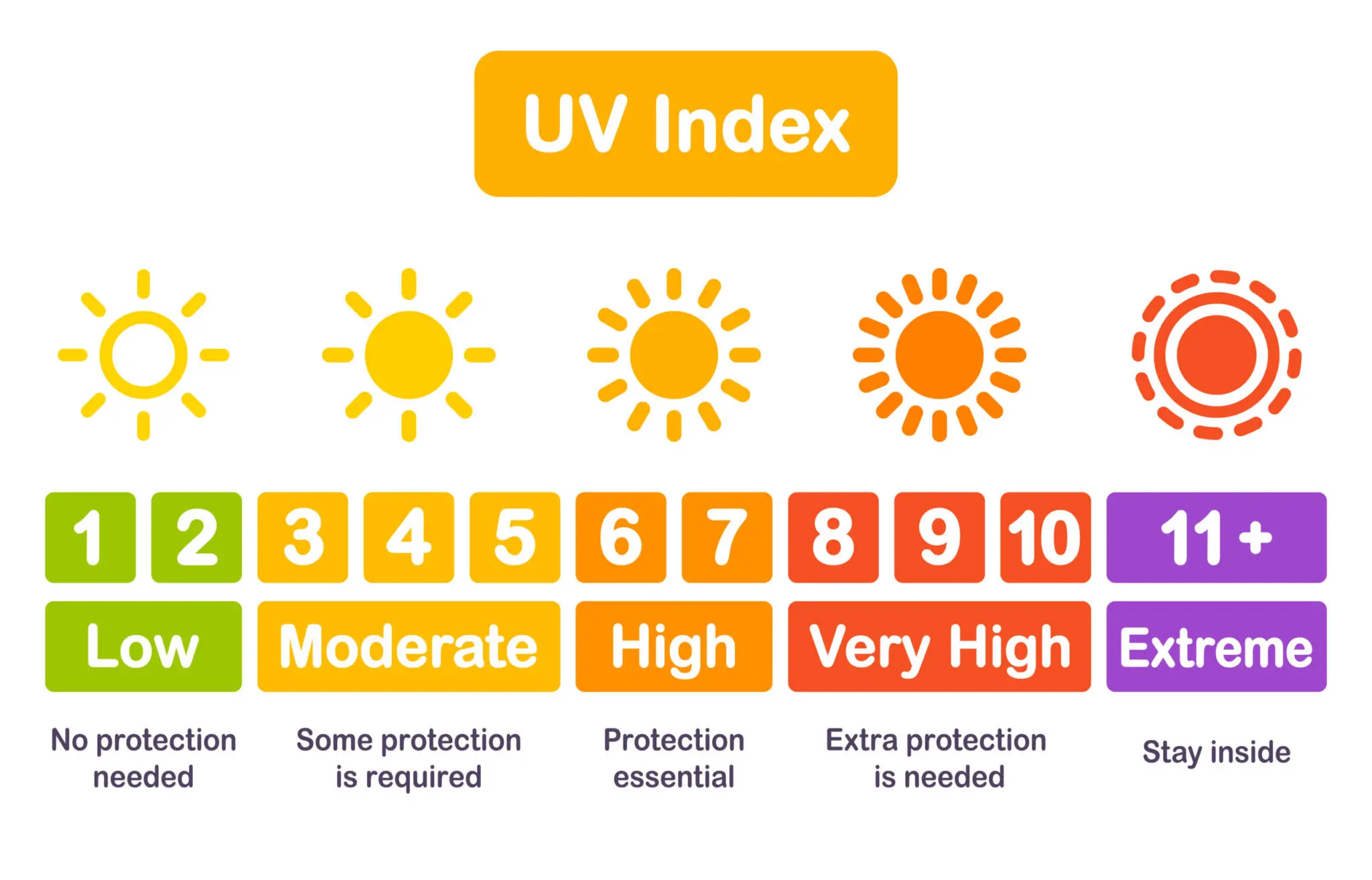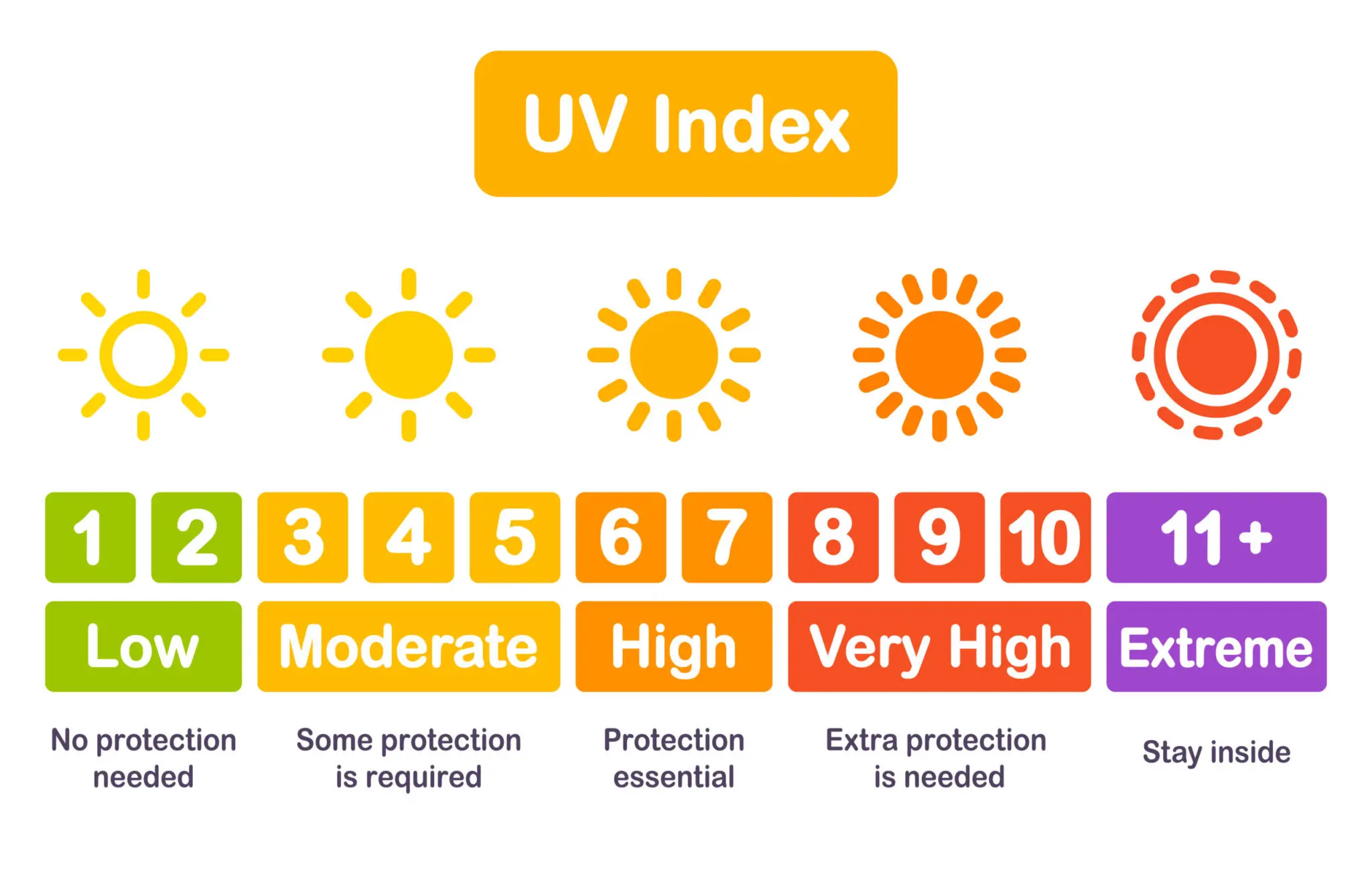As the days get longer and the temperatures get warmer, many of us are eager to get out in the sun and start soaking up some rays. But with the dangers of sunburn and skin cancer, it’s important to make sure that we’re properly protected. In this article, we’ll explore what UV index is and the best UV index to tan safely.
Before laying out in the sun, it’s important to know the UV index. The UV index measures the intensity of ultraviolet radiation from the sun. A good UV index for tanning ranges between 3 and 7. Anything above 8 is considered too intense, and you should take extra precautions to protect your skin.
If you’re looking to get a tan, you should stay in the sun for 10-15 minutes a day when the UV index is between 3-7. It’s important to wear sunscreen with SPF 15 or higher and reapply it every few hours.

Contents
What is a Good UV Index to Tan?
The UV index is a measure of the strength of the sun’s ultraviolet radiation on a scale of 1 (low) to 11+ (extreme). It is used to determine the need for extra protection from the sun, such as wearing sunblock or sunglasses. The higher the UV index, the higher the risk of skin cancer. So, what is a good UV index to tan?
The ideal UV index to tan is between 2 and 5. At this level, the sun’s UV rays are strong enough to stimulate the production of melanin in the skin, but not so strong that it causes serious damage. A good tanning session should last no more than 15 minutes at a time, and sunscreen should always be used.
It is important to remember that the UV index can vary depending on the time of day and the season. In the summer months, when the sun is strongest, the UV index can reach up to 11 or more. Even at a lower UV index, it is important to wear sunscreen and protective clothing when spending time outdoors.
Tanning Process
Tanning is the body’s natural response to the sun’s ultraviolet rays. When the skin is exposed to the sun, it produces more melanin, which is a pigment that gives the skin its color. Over time, this pigment will darken and the skin will appear tan.
The amount of time it takes to get a tan depends on several factors, including the skin’s natural pigment production and the strength of the sun’s rays. People with darker skin may need to spend more time in the sun to achieve the same tan as someone with lighter skin.
Risks of Tanning
Tanning carries certain risks, even at a low UV index. Too much exposure to the sun can cause sunburns, wrinkles, and even skin cancer. It is important to take precautions when tanning, such as wearing sunscreen and protective clothing and limiting exposure to the sun.
It is also important to remember that tanning beds are not a safe alternative to natural sunlight. Tanning beds emit much stronger UV rays than the sun, and can cause skin damage more quickly.
How to Protect Your Skin from UV Rays
The best way to protect your skin from UV rays is to wear sunscreen with a minimum SPF of 30. Sunscreen should be applied every two hours, and after swimming or sweating. It is also important to wear protective clothing, such as a hat, long sleeves, and sunglasses.
It is also important to limit exposure to the sun, especially during the middle of the day when the UV rays are strongest. Seek shade or stay indoors when possible.
What to Look for in Sunscreen
When choosing a sunscreen, look for one that is labeled “broad-spectrum,” meaning it offers protection from both UVA and UVB rays. Also, make sure it is water-resistant and has an SPF of at least 30.
It is also important to choose a sunscreen that is hypoallergenic and free of fragrances and other irritants. If you have sensitive skin, look for sunscreens that are specifically formulated for sensitive skin.
Tanning Alternatives
If you want to achieve a sun-kissed look without exposing your skin to the sun’s UV rays, there are several alternatives. Self-tanning lotions and sprays are a great option, as they provide a natural-looking tan without any of the risks associated with tanning.
Airbrush tanning is another option. Airbrush tans are applied with a machine, giving an even color with no streaks or missed spots.
Conclusion
The ideal UV index to tan is between 2 and 5. Even at this level, it is important to take precautions to protect your skin from the sun’s UV rays, such as wearing sunscreen and protective clothing. There are also several alternatives to tanning, such as self-tanning lotions and sprays, and airbrush tanning.
Top 6 Frequently Asked Questions
What is UV Tanning?
UV tanning is a type of tanning that uses ultraviolet light to darken the skin. This type of tanning is becoming increasingly popular because it is less damaging to the skin than other types of tanning such as tanning beds or sunbathing. UV tanning is typically done in a tanning booth or with the use of a spray-on tan. UV tanning works by exposing the skin to ultraviolet light, which causes the skin to produce more melanin. The increase in melanin causes the skin to darken, resulting in a tan.
What are the Benefits of UV Tanning?
There are many benefits to UV tanning, including improved skin tone, a healthier-looking complexion, and protection from sunburns. UV tanning can also help reduce the appearance of blemishes, wrinkles, and age spots. Additionally, UV tanning can boost your mood and confidence by giving you a more attractive appearance.
What is a Good UV to Tan?
The best UV to tan is one that is tailored to your individual needs. Depending on your skin type and desired results, the best UV to tan could be a low-level tanning bed, a spray-tan, or even self-tanning lotion. It is important to speak to a qualified professional to determine what type of UV tanning is right for you.
What are the Risks of UV Tanning?
Although UV tanning can provide many benefits, it can also come with risks. UV tanning can cause skin damage, including premature aging, wrinkles and age spots. Additionally, UV tanning increases the risk of skin cancer, as well as eye damage. Therefore, it is important to be aware of the risks associated with UV tanning and to take the necessary precautions to protect your skin.
How Can I Protect Myself When Tanning With UV?
When tanning with UV, it is important to protect your skin from damage. This can be done by wearing protective clothing, such as a hat and sunglasses, and by using sunscreen with a minimum SPF of 30. Additionally, it is important to limit your exposure to UV, as overexposure can lead to serious health risks.
What are the Alternatives to UV Tanning?
If you are looking for a way to tan without using UV, there are several alternatives. These include using self-tanning lotions, spray-tans, and tanning creams. These methods can provide a natural-looking tan without the risk of skin damage associated with UV tanning. Additionally, these products are typically easy to use and can provide results in as little as a few hours.
7 SECRETS To Achieve a TAN Fast
Tanning with a good UV is an important part of maintaining a healthy-looking skin, and there are many products on the market that can help you do just that. With the right product and careful application, you can get the perfect tan and enjoy the summer!








